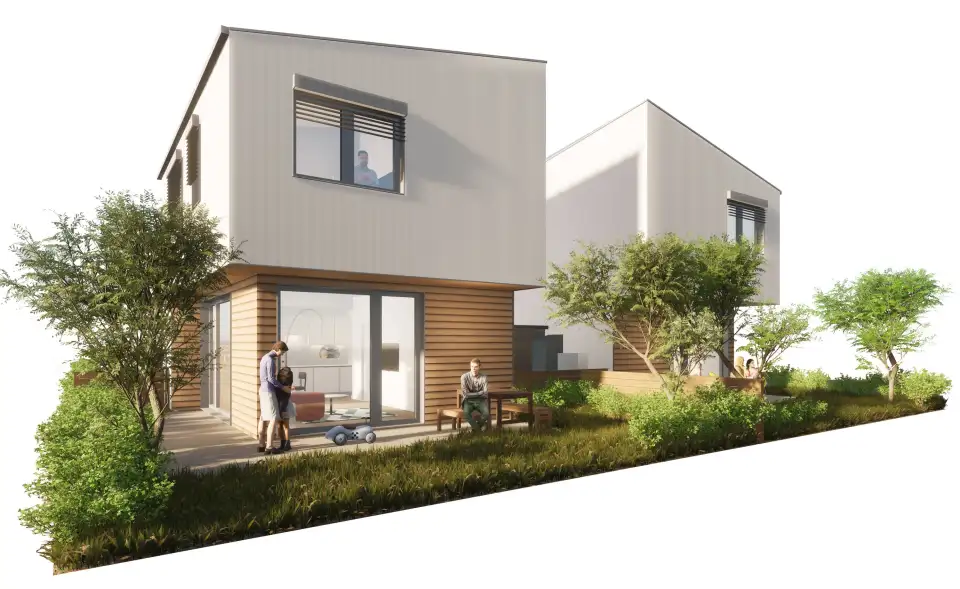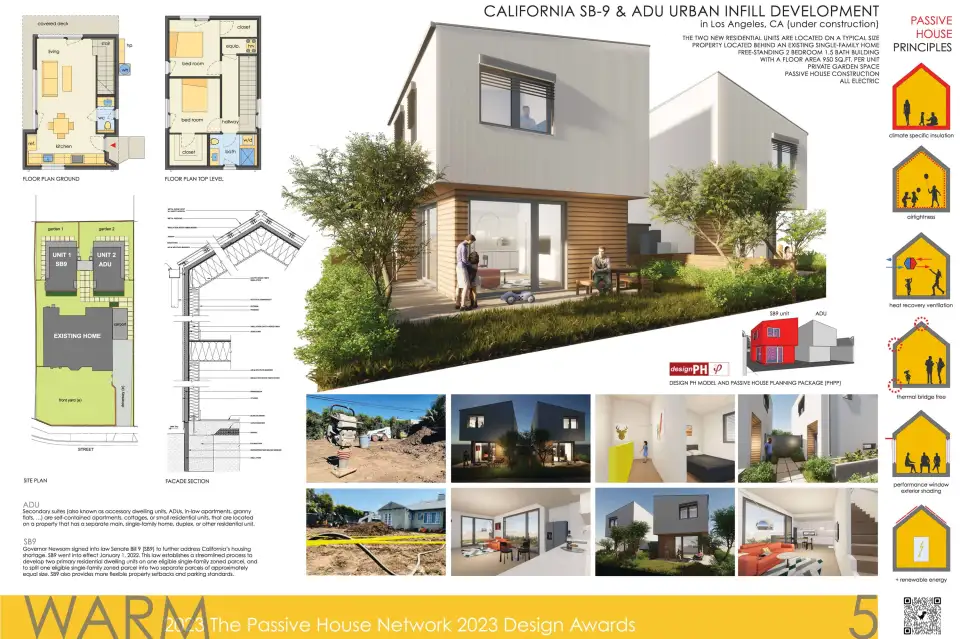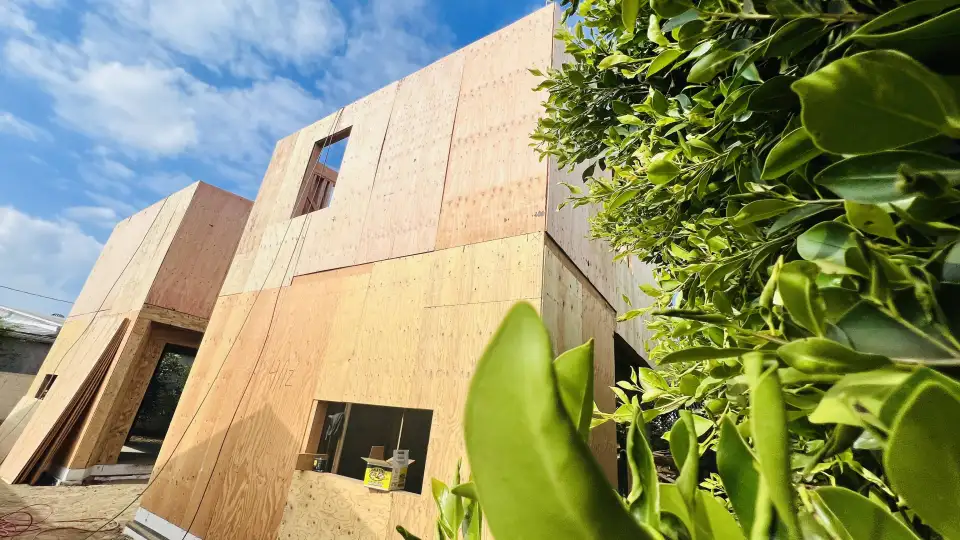
No matter how one parses the numbers, California’s housing supply is insufficient—especially reasonably priced housing. To address this crisis, the state legislature has been passing a raft of measures aimed at streamlining the construction of new housing. Chief among those was the California Housing Opportunity and More Efficiency (HOME) Act, which became law in January 2022 and is more familiarly known as Senate Bill 9 (SB9). This act eases the process for legally constructing a second unit on a single-family parcel. Given that previous legislation facilitated the construction of accessory dwelling units (ADUs) on single-family lots throughout the state, SB9 paves the way for legally building up to four dwellings—two residences and two ADUs—on one residential parcel.
Christian Kienapfel, principal of PARAVANT Architects, which is based in Los Angeles, was approached by a client a few years ago to help him replace his existing garage with an ADU. After becoming familiar with SB9, the client decided to expand the number of his rental units and build one additional house and the ADU. Although they are technically different types of structures, the two buildings are in fact identically sized mirror images of each other. Both buildings are just shy of 1,000 square feet, and both are being built to meet the Passive House standard, which is finally gaining some traction in the City of Angels.

Los Angeles’ westside has a mild climate, softened by its iconic Pacific breezes. Six years ago, when Kienapfel built his own Passive House here, interest in this high-performance building standard was almost nonexistent. “It was difficult to convince people, because there were no examples here,” Kienapfel explains. But, then came Covid. “If you have an uninsulated house, which most houses here are, they're just uncomfortable and people discovered that during the pandemic,” he says, noting that he would hear variations of: Oh my God, I'm stuck in my house, and it's so uncomfortable. For Angelenos, it turns out, comfort is important.
Another LA lure is being a trendsetter, even when it comes to reducing one’s carbon footprint—along the lines of driving an electric vehicle 10 years ago. And, some people have heard of Passive House and just want the best building possible. “The idea of having a very efficient building and then supplementing it with a very small solar system and basically being almost self-sustainable, that's something which is of interest to a lot of clients here,” he notes. In the handful of years since building his home, PARAVANT Architects has moved from no Passive House clients to a busy roster of Passive House projects, mostly in the greater Los Angeles area.
“We had hundreds of people going through our Passive House home—before the pandemic, of course,” Kienapfel elaborates, “And the interest is increasing, especially in air tightness, because it allows you to filter the air and control what goes into the house.” For clients with allergies or other health issues, controlling air movement can be a big selling point. Furthermore, as Kienapfel points out, because LA’s climate is mild and California’s building energy code is relatively good, airtightness is the Passive House measure that brings the biggest savings, because the State’s code has no airtightness requirement.
For the two new homes’ air barriers, Kienapfel has specified a combination of membranes and liquid-applied sealants in the rough openings with Pro Clima's "ADHERO 3000," sourced from 475 High-Performance Building Supply, being used for the air barrier and water control. To the exterior of the membranes the wall assembly will include two inches of continuous Rockwool Comfortboard topped by a rain screen stucco system with a drainage layer, because it does actually rain in LA. He notes that he has seen older stucco homes in which moisture had deteriorated the building paper behind the stucco and then fostered rot in the wood structure—clearly an issue to be avoided.
Preventing summertime overheating is another major LA concern, and to address this, Kienapfel is relying principally on high-performance IKON windows with low SHGC (solar heat gain coefficient) glazing, along with careful detailing of the shading strategies. The client was excited about IKON’s range of offerings, including its large-scale windows and tilt-and-turns, and charmed by the warmth of its interior wood frames combined with the aluminum cladding on the outside for durability. In both houses the windows are recessed into the assembly, and the large ground-floor windows and deck doors are stepped back and partially shaded by the upstairs floor that overhangs them. “It was important to him that, if he builds a Passive House, it should look different, and it should have a special feel to it—a new surprise factor and a quality-built factor,” says Kienapfel, adding, “And that's why we chose these windows. They also had a very favorable lead time in comparison to competitor products.”
The buildings are all electric, with an HRV for filtered, fresh air and a small heat pump mini-split providing heating or air conditioning for the relatively short periods when that’s needed. In his own house, Kienapfel rarely turns on his air conditioning—just during the generally brief heat waves.

Fifteen years ago, says Kienapfel, the Hummer was the preferred vehicle in Los Angeles. Fortunately, that trend is so passé. His clients pull up to his office now in a Tesla, and they want a high-performance home, not one built the way housing was constructed 50 years ago. “They want to be on the forefront, and they want a Passive House,” he says. Of course, he is happy to oblige, and is also happy to report that getting the specialty products he needs—HRVs, air and vapor barriers, and high-performance windows—has gotten much easier since he built his own home. “The market is evolving,” he notes contentedly.
Each new housing unit in California is chipping away at the large gap between supply and demand. These two Passive Houses are doubly helping out the State, by adding density in an area that desperately needs it while not contributing significantly to the area’s peak power demand. It’s LA living at its best.

|
Team Members: |
|
|---|---|
|
Architect: |
PARAVANT Architects |
|
CPHD/C: |
Christian Kienapfel |
|
PH-Certifier: |
Steve Mann |
|
Design Team: |
Siavosh Sepanta, Frank Maldonado, Christian Kienapfel |
|
Contractor: |
Alberto Canseco & Team |
|
Soil Engineer: |
Grover-Hollingsworth & Associates |
|
Structural: |
Paul Trung, Get Structural |
|
Title 24: |
Home Energy Services |
|
Expediter: |
Liberty Bakunin |
|
Owner: |
Michael Soehner |